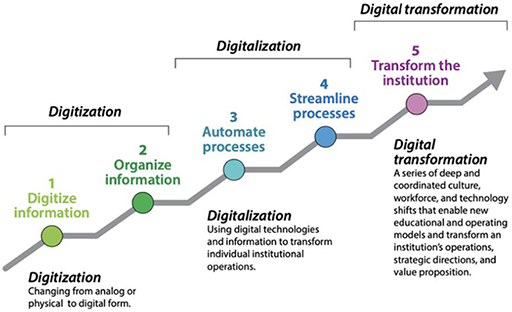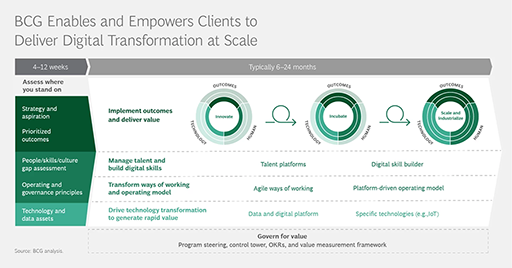7.1 Digital leadership
For organisations to successfully digitally transform they need to cultivate digital leadership skills. Digital leaders do not have to be experts in technology but need to have the knowledge to be able to make connections and have conversations that enable the organisation to embed a digital first culture.
Having a digital common language for leaders, is an approach that can simplify technology jargon, and help focus on the opportunities and risks to enable digital transformation. Deloitte Insights suggest:
By embracing a common language, organisations can begin to:
- Break through human behavioural and structural barriers. Everything in an organisation is interconnected. Leaders across functions can speak thematically about shared needs, avoid redundant investments, address emerging risks, and change processes at scale by simply communicating better.
- Plan beyond a single technology. Platforms, capabilities, and initiatives often involve multiple digital and physical technologies securely working together. As these technologies combine, they become greater than the sum of their parts to bring new capabilities and greater value.
- Evolve into the future. Today’s breakthrough technology is tomorrow’s legacy tech. A common language can enable leaders to think flexibly across a matrix of business and technology needs, without having the business strategy reliant on any single technology.
- Achieve a greater strategic business value through its capacity to change and ability to win. This approach helps organisations better align and execute against their business strategy to achieve their desired results of advantage and adaptability of the organisation, humans, and technology.
Source: Deloitte [Tip: hold Ctrl and click a link to open it in a new tab. (Hide tip)]
Activity 19: What does a digital leader look like?
Watch the video in which Jacob Morgan shares the skills for digital leadership.

Transcript
Then browse the following articles:
6 Characteristics of Digital Leadership
What do you think is required for digital leadership? You may wish to make notes in the free text box below.
Digital leaders also need to plan a strategy to ensure that all employees have the digital capabilities, skills and behaviour necessary to harness digital tools and data, and have an awareness of the differing needs of their employees, students (for HEIs), and wider community.
Activity 20: Six factors for successful digital transformation
The Boston Consulting Group (BCG) recommends six factors for successful digital transformation:
- Integrated strategy with clear transformational goals.
- Leadership commitment from CEO through to middle management.
- Deploying high-caliber talent.
- An agile governance mindset that drives broader adoption.
- Effective monitoring of progress towards defined outcomes.
- Business-led modular technology and data platform.
Source: BCG: Digital Transformation
Watch the video The keys to digital transformation: getting the success factors right which explains the six factors. As an optional activity, you may also wish to visit BCG article Digital Transformation Strategy Consulting | BCG which about half way down has additional videos on each of the factors and explains.
How could leaders use these factors to develop their organisations approach to digital transformation? You may wish to make notes in the free text box below.
BCG’s approach to digital transformation starts by assessing where an organisation is today, and where it wants to go. The image below shows the timescales and the outcomes that organisations may aim to achieve.
Activity 21: Explore what digital transformation for HEIs might involve
In this section we have looked at digital transformation in the wider context predominantly aimed for the corporate world, which is important when thinking of HEIs in the context of a business.
Reflect on the Hybrid Ways of Working: A Contextual Framework, the Digital Strategy for Wales and the activities earlier in the course exploring your internal and external environment. While HEIs need to operate as a business, they also have to consider the needs of their students, approach to pedagogy and delivering teaching and learning, which the pivot to online learning during the COVID-19 pandemic has led many institutions to offering a blended learning approach.
Then read the following articles:
Tackling digital transformation together
Consider the Three Ds When Talking about Digital Transformation
Educause suggest a Three Ds approach to digital transformation for HEIs – Digitisation, Digitalisation and Digital Transformation.

Reflect on the Educause article, and consider what elements from the BCG and the Three D’s approaches can enable HEIs to digital transform and achieve the outcomes of the Digital Strategy for Wales and the A Prosperous Wales wellbeing goal – Skills for the Future successfully?
You may wish to make notes in the free text box below:

